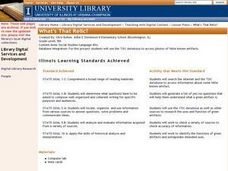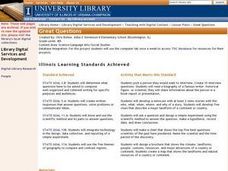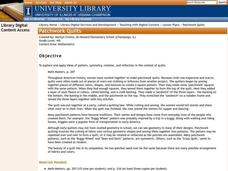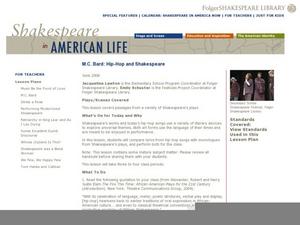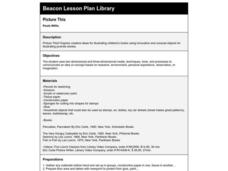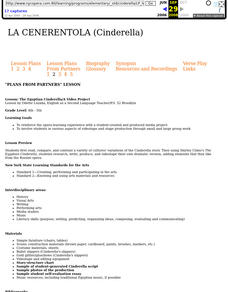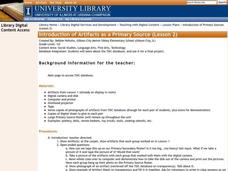Curated OER
What's That Relic?
Fifth graders listen to a read aloud of David Mc Cauley's book Motel of the Mysteries. They discuss an unknown artifact and decide what it might be used for. They research other artifacts and play "What's that Relic?"
Curated OER
Great Questions
Fourth graders research and create questions about a famous person. They create questions in a game format, create a computer generated brochure, and develop rubrics for their finished projects.
Curated OER
Patchwork Quilts
Fourth graders examine about traditional quilting patterns, the symmetry in such patterns, and practice creating patterns of their own. They design a quilting pattern, and groups make colorful "patches," of a pattern. They assemble the...
Curated OER
Map Directions and the United States
Third graders search TDC database for images of a compass rose, a miles marker, and a US map. They identify cardinal and intermediate directions to help identify their state and other states on a US map.
Curated OER
People and Their Place in the Community
Third graders search TDC database for images of famous people, such as Rosa Parks, Gandhi, Martin Luther King Jr., etc. They also retrieve information about their accomplishments, time frames, areas, and how they made a difference in...
Curated OER
Prairies
students make booklets about each of the following: reptiles, birds, plants, animals and buffalo. Each was information and contained the facts covered in class. they research one specific area in which they were especially interested....
Curated OER
Read All About It! California History of the 30s and 40s
Explore the Great Depression! Discover the challenges people experienced during the time period. Learners investigate photographs from the Dust Bowl and WWII era and create a story line about the photographs, writing a newspaper article...
Curated OER
Melba Pattillo and Ruby Bridges: Two Heroes of School Integration
Learners put themselves in the shoes of students who integrated Little Rock High School in 1957-58. Note: The primary resources in this activity provide powerful and poignant descriptions of what those students faced.
Library of Congress
Stars, Stripes and Symbols of America: Comparing Our Flag, Past and Present
Your young historians will compare and contrast the details of the American flag today with an an image of the nation's flag from the post-Civil War era, and identify the flag's importance as a national symbol through analysis worksheets...
Curated OER
Presidents Picture Book
Learners create a picture book of the U.S. presidents. They study general information about the U.S. presidents, write a sentence about each president, and create a picture book about the U.S. presidents.
Curated OER
M.C. Bard: Hip-Hop and Shakespeare
What is poetry? Does hip-hop qualify as poetry? Do Shakespeare's monologues qualify as poetry? Class members grapple with these questions as they examine the poetic elements and themes presented in different texts. Groups of four study...
Curated OER
"Music Be the Food of Love:" Found Poetry with Shakespeare and Hip-Hop
Lines from Shakespeare and from hip-hop artists provide learners with an opportunity to examine the literary devices these artists use to express their ideas about love. Groups use the provided lines to craft found poems, and then the...
Curated OER
Arizona Plant Booklet: An Introduction to Arizona Plants & Cacti
Young scholars explore variety of plants & cacti in their Arizona community by collecting samples and taking photographs. Can be adapted to other areas.
Curated OER
Descriptive Writing: Using Art to Inspire description
Write with the senses! Try using art to inspire writers to consider all of the senses. Here, the class is divided in half. Each group looks at one of two images, imagines the senses that would be engaged, and records answers to five...
Curated OER
Memorial Day Shoebox Parade
Learners examine the history of U.S. conflict and Memorial Day. They conduct research, develop a timeline of U.S. conflict, and create a shoebox Memorial Day parade to commemorate veterans and soldiers.
Curated OER
Nutrition and the Media: Cereal Box Consumerism
How many treats do you buy each week? Learners investigate diets and how the media tricks consumers into purchasing unhealthy snacks. They will investigate the designs and logos affiliated with cereal boxes and identify specific phrases...
Curated OER
Burr Airlines Flight to Asia: Building Inquiry Skills
What a wonderful way to explore this topic! Learners take an imaginary trip to Asia, take a visual tour, and formulate questions for a research project. As a final project, they create a travel brochure.
Curated OER
Simple Machines
Have your class conduct research to learn all they can about simple machines. They use the web, take notes from a video, write a script, then make a film describing various simple machines found in real life. These videos are then...
Curated OER
Exploration of the Americas
Third graders demonstrate knowledge of exploration by naming and describing accomplishments of explorers. They use the internet to find corresponding information on the explorer and fill in a chart that is provided. Students also...
Curated OER
Rain Forests
Students investigate the animals and plants of the rainforests. They define rainforest, watch and discuss a National Geographic video, and write a short story.
Curated OER
Masks
Students examine traditional masks from Southwest Indian groups and create their own mask based on Internet research. They share their mask with the members of their class.
Curated OER
Picture This
Fourth graders use two-dimensional and three-dimensional media, techniques, tools, and processes to communicate an idea or concept based on research, environment, personal experience, observation, or imagination.
Curated OER
La Cenerentola (Cinderella)
Students reinforce the opera-learning experience with a student-created and produced media project. Also, students get involved in various aspects of videotape and stage production through small and large group work
Curated OER
Introduction of Primary Sources
Students will use the internet to access information about artifacts to justify their use as primary sources of information. The activities can be done as a whole class or in groups. The differences between primary and secondary sources...


